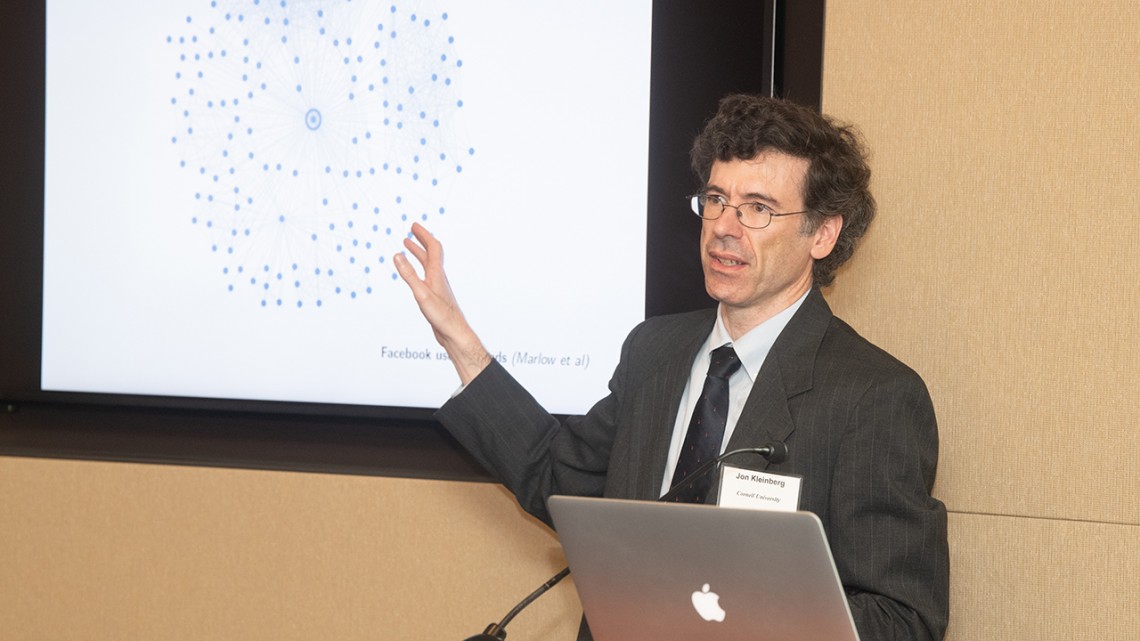
Jon Kleinberg, the Tisch University Professor of Computer Science, gives a briefing about mathematical models and networks June 13 on Capitol Hill.
Math can protect society’s networks, Kleinberg says in D.C.
By Melanie Lefkowitz
Mathematical and computational models can make power grids, financial institutions and other networks less vulnerable to collapse and help information networks spread important messages faster, Jon Kleinberg, the Tisch University Professor of Computer Science, said at a June 13 presentation on Capitol Hill.
Networks arise in systems when individual entities become connected. Some are physical, such as the power grid; others are intangible, such as social networks. They have implications for everything from the spread of contagion and disease to the sustainability of the global food chain, Kleinberg said, and developing ways to spot or possibly exploit their weaknesses can help keep them stable.
“When we keep adding nodes and connections, these links allow systems to become extremely large and span the entire world,” Kleinberg said. “But the fact that they’re connected enables problems in one part of the system to spread rapidly to other parts of the system. That’s where we need mathematical and computational models to understand how this spread works.”
Problems spread through a network via contagion, such as when infections are passed on due to proximity, or because of cascading failures, which cause the entire network to unravel because the nodes depend on each other. Studying the way networks behave can help researchers understand and predict events that might cause network collapses, Kleinberg said.
In his talk, he highlighted the importance of choosing the right network structure and analyzing it correctly, to distinguish between contagions that spread at close or long range in order to accurately model their spread. To prevent cascading failures, he said, it’s often important to identify and protect the network’s most fragile parts.
“It generally isn’t the best strategy to try protecting all parts of the network uniformly or evenly, because some parts of the network tend to be much more critical than others,” he said. “Having models that pinpoint the most vital areas of the network to protect is something we see as a theme in the prevention of disease epidemics, but also in things like trying to find the most critical parts of a power grid or a banking system.”
Identifying critical parts of networks is not only important in preventing failures, he said, but can be useful in trying to maximize the spread of important information in a network.
“Then the goal might be to find the critical parts of the network where we can introduce our message so it spreads as widely as possible,” he said. “The things that can be threats in one context can be opportunities in another.”
Cascading failures tend to be fragile at first, gaining momentum as they progress. Predicting the course of these cascades is still a relatively unexplored area of research, Kleinberg said, and can be important in looking for early warning signals about crises or trying to stop them in their early stages.
For example, researchers retroactively studying financial networks just before the start of a financial crisis spotted warning signs that could have served as potential danger signs.
“If we had the right lens for measuring these things, we might have been able to spot some of these problems earlier than we did,” he said. “So that’s an opportunity for mathematical and computational models to potentially help as we look at these large networked systems.”
Kleinberg’s talk, in the Rayburn House Office Building, was organized by the Mathematical Sciences Research Institute and the American Mathematical Society, which run biannual briefings in Congress about the ways mathematical research and applied mathematics can impact societal problems.
Media Contact
Get Cornell news delivered right to your inbox.
Subscribe
